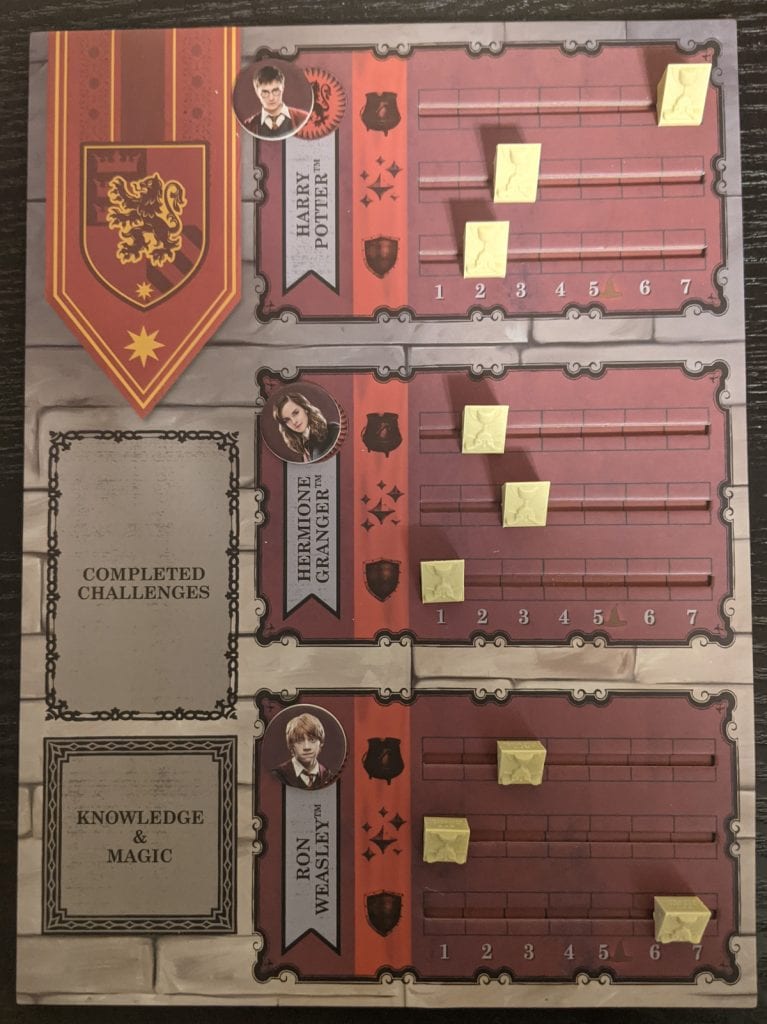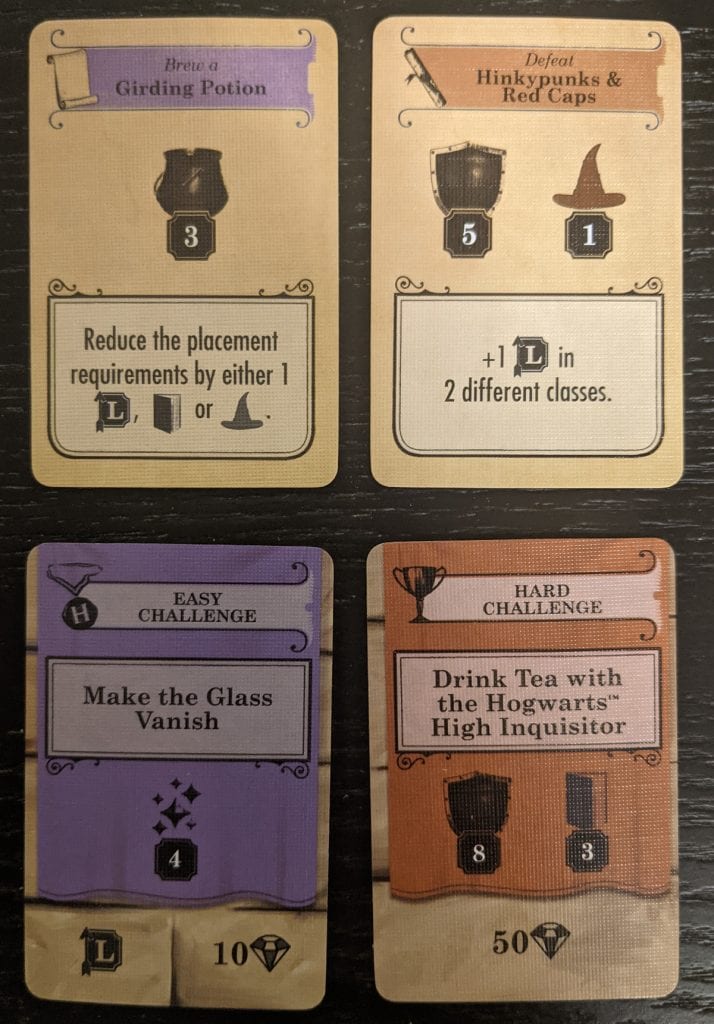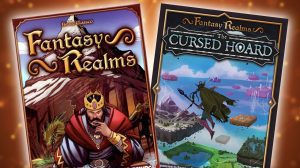Disclosure: Meeple Mountain received a free copy of this product in exchange for an honest, unbiased review. This review is not intended to be an endorsement.
Let me be clear before we start: I am not into Harry Potter.
My only exposure to the series is the first book that I read back during the slow periods in high school (it’s been that long?) and getting dragged by my childhood friend to see the third movie with her. I didn’t see the first two movies, so I was on a one-way cruise trip to an ocean of confusion. I felt like an out-of-touch parent watching the First Pokemon Movie with their kids.
Yet my lack of interest in a game’s franchise wasn’t a barrier to me in other titles. I never watched Spartacus, but I still reviewed the game. I owned the board game Sons of Anarchy with all the expansions and never eyeballed a single episode of the show.
As if that weren’t enough, this game is also a worker placement game, a genre that I often avoid. Why would I be interested in this game then? After reviewing The Alpha, I was a bit more open to worker placements if it had an entry-level profile and a short time.

Sorting Hats
As one would expect from a Harry Potter game, you’ll be shuffling these famous fictional characters around to earn resources and score points. You control one of the four houses (Gryffindor, Slytherin, Ravenclaw, or Hufflepuff), with each House having three students.
Like any worker placement game, you’ll send one of your students to an empty spot each turn and reap the rewards. After claiming a spot, no one else can visit it for the rest of the round. It sounds pretty vanilla so far until you realize that each student has their own stats which start at Level 1.
This is a massive twist since the conventional worker placement design doesn’t give any sort of differentiation between your workers. They were simply a marker to claim a spot, nothing more. Allowing each piece to have its stats shifts the mindset in a whole new direction. You no longer only have to worry about the timing of your placements, but who you send as well. A simple framework that even the newest of gamers can easily grasp with no straightforward answer for the experienced.
What are these stats? Potions, Charms, and Defense. Mechanically speaking, there isn’t any difference between them, and you use them to complete Lessons and Challenges. Outside of that, you can also gain Magic and Knowledge tokens. Some Lessons and Challenges require you to spend these tokens, while some worker spots have a Knowledge and Magic cost to use them.

Being A Good Pupil
You start the game with two Lesson cards, and you can play them either before or after you place your student. Each lesson card lists a particular requirement to fulfill, such as Level 2 Charm and offers a reward such as an extra action, stats, points, or resources. Only the active student can complete the Lesson Cards, making the order of activation a very significant decision. Grabbing these cards is done by sending your students to particular spots, similar to gaining tokens or improving your students’ stats.
While that sounds basic, it is a feature that I adore. One of my many complaints about the worker placement genre is the lack of alternatives to get the resources you need due to the limited spots. Lesson cards offer a different way of getting resources but in a somewhat random manner. This is a little extra reward that your students will receive from the space you decide to send them to. It’s a bit like winning a slot machine with a low payout accompanied by a slight hint of dopamine kicking in.
If you want to score the big points, you need to nab those Challenge cards. After everyone has pushed their three students to the various places, it’s time to recall them back and assign them to the Challenge cards in your hand. Like the Lesson cards, they have particular requirements to fulfill except with higher numbers. In contrast to Lesson cards, you can assign multiple students to a single Challenge card and combine their stats. As you would expect from licensed games, these Challenges refer to various events that happen in the Harry Potter books.

Crafting The Narrative
As weird as this sounds, I like this setup. Instead of following a strict narrative faithful to the Harry Potter universe, you get a blank page and a pen to write an alternative timeline with your friends.
In my first game, I was the Slytherin house, and we were masters of Defense and decent at Potions. Charms? My students skipped class for that one. One of my friends was house Gryffindor. Harry Potter was such an alchemist expert that Walter White started taking notes, whereas Hermione was a useless student. I am probably overstating the importance of this, yet I can’t help but love licensed board games that allow me to muck everything up. It’s too amusing for me to ignore.
This cycle of sending your students to finish lessons and complete challenges will repeat for seven rounds. As the rounds progress, locations will open up for more options to achieve your goals. After seven rounds, the highest score is the winner.
The Final Exam
One of the biggest challenges of a reviewer is to get into the mindset of the game designer. I could take the easy route and say, “the game is bad because I didn’t like it,” but that would be lazy. I prefer to understand the designer’s intentions of their work and evaluate from there. So what is the deal with the Harry Potter House Cup Competition? It’s an entry-level worker placement game meant for families. From a design perspective, the mechanisms hit this mark quite well. Too well.
A noteworthy entry-level game isn’t just the ease of play. It’s the old standby cliche of “easy to learn, hard to master” that is tattooed to our brains at this point. Games like Carcassonne, Ticket to Ride, and Settlers of Catan have been in print for decades because while they are easy to teach, you can sink your teeth into them without hitting a bone.
The biggest issue with House Cup Competition is that it does not go far enough. It has this great idea about using cards to get bonuses and each student being upgradable throughout the session. A part of me wishes it had gone beyond the baseline to add some competitive edge to make the sessions more engaging. Instead, we have a “by-the-numbers” strategy game about hitting certain thresholds to score points without much else to offer. It likes to plant itself in the corner, to the point where even an introvert like myself would tell it to mingle with the crowd.

The Bad And The Ugly
Even the presentation itself lacks confidence. You have this beautiful scoring set piece that has four plastic tubes as if stolen from a science set, and you fill these tubes with colored plastic jewels to signify points. Then you see the board and wonder what happened. The board is an endless desert of basic boxes and each Challenge or Lesson card has the exact same template with no art piece showcasing the event. It shocked me since this is a board game wrapping itself with the clothes of a popular franchise, so I would expect some good art. The art direction of this game feels like someone being cute with Microsoft Excel.
It’s also a bit of an obstacle for people not familiar with the Harry Potter universe. The worker pieces you place in the game show photos of the characters, while the boards where you keep track of their stats do not, just names. I hope you know who Cedric Diggory is because I do not.
The Harry Potter Cup Competition has all the makings of a solid game, but fails to make use of its bedrock of mechanisms to create a memorable experience. If you are looking for a worker placement game that offers some engaging depth to explore, House Cup Competition isn’t the ocean you want to dive into.
You can purchase a copy of Harry Potter House Cup Competition on Amazon US












Add Comment